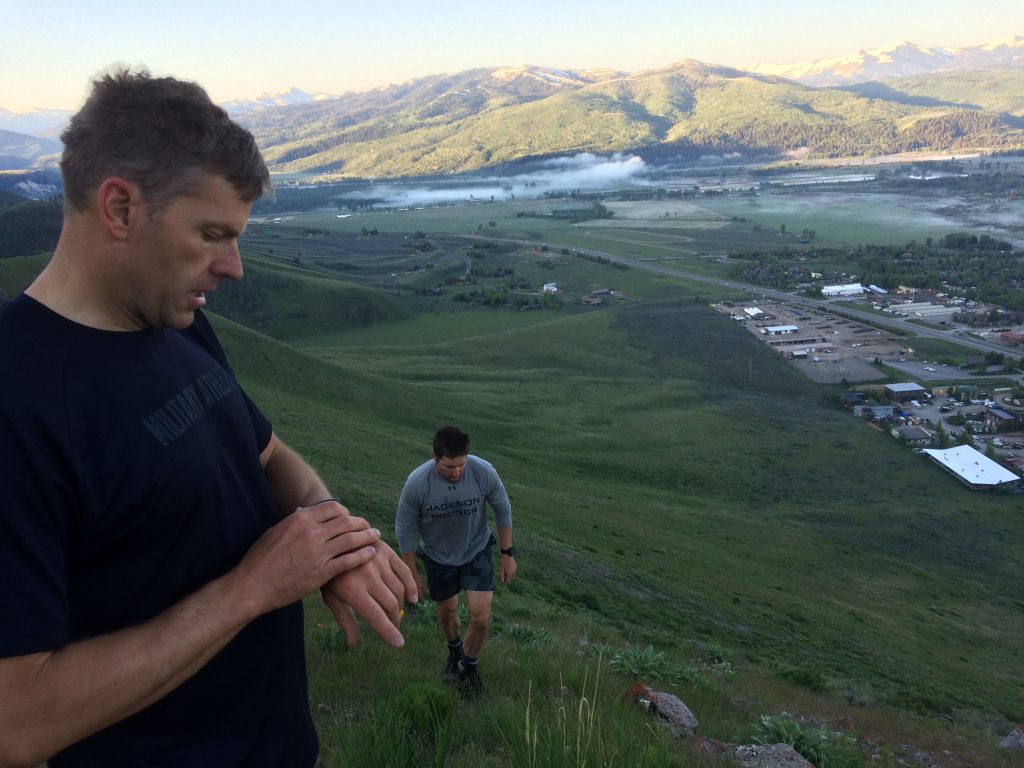
By Rob Shaul
The decision to term MTI daily fitness a “Training Session” and not a “Workout” is intentional.
Athletes who follow MTI programming don’t “workout.”
We “Train.”
The difference includes purposeful intention, program design, a focus on outside performance, and cycle-specific progression.
In the fitness world, “workouts” stand on their own. Crossfit’s WOD, Peloton’s 30-minute spin classes, or Beach Body’s daily pump stand independent of the workout the day before and what follows the next day. Athletes may drop in and out of these workouts as their schedule or motivation dictates.
The goal is to get in daily exercise – not “train” toward a fitness goal. Get your “workout” in, and move on to something else.
Often, the motivation for “working out” isn’t fitness improvement at all, but physique improvement (looking good). There’s nothing wrong with this as 99% of the fitness industry is based on vanity, but again, focused fitness improvement is MTI’s the goal, not physique improvement.
MTI’s fitness programming is laser-focused on improving mission-direct fitness for outside performance. I’ve answered dozens of emails from first responders or military athletes who want to improve their mission direct fitness, but also increase the size of their chest and arms. I always take time to explain that these may not be the same thing.
MTI’s Daily Training Sessions are part of a bigger meso-cycle (multi-week) plan/goal at a minimum, and for our base fitness programming, a small part in a much larger macro-cycle (multi-month) plan.
MTI’s Training Sessions are progressive – i.e. they build upon one another. Often that day’s programming is based on a previous assessment. Its position in the week “fits” with the other training sessions scheduled for that week.
Meso-cycles (multi-week) have specific training goal outcomes. For our event-specific plans like tactical PFT plans, selection plans, mountain sport pre-season plans, and our fitness-specific plans like running and strength plans, these training goals are directly tied to the event or fitness goal. Every exercise, progression, run, or ruck distance in the Ranger School plan is specifically prepared to prepare the athlete for the fitness demands of Ranger School. Every training session in the MTI Relative Strength Assessment Training Plan is specifically designed to improve the athlete’s front squat, bench press, hinge lift, or pull up strength.
Base fitness meso-cycles, like the tactical Greek Hero, Gun Maker, Notorious Prison plans are designed to work together with each other to build and maintain the athlete’s mission-direct “base fitness” level. The same is true for the mountain athlete Greek Heroine plans and the mountain professional Wilderness plans.
Fitness is not a sport for us. It’s a means to an end … specifically, outside performance.
A unique reality for the mountain and tactical athletes we work with is they can and do get severely injured and even perish, doing their mountain sport, mountain professional job, or tactical duties. Mission-direct fitness can help our athletes avoid injury, if they do get injured, not get hurt as bad and recovery quicker. Fitness aimed at survivability is a clarifying focus for MTI programming.
I don’t deny that turning fitness into a sport is great for business – look at the success of CrossFit or the leader boards on Peloton – or that it engages athletes. Often, athletes who’ve come to us after CrossFit have missed the daily competition and ranking, as well as the sense of community many of these gyms have.
I’ve been asked many times to do a CrossFit-like record board/forum for training sessions but have resisted. From a strength and conditioning perspective, I’m more interested in the individual athlete’s improvement from the beginning of the cycle to the end, as well as his/her performance on the job-specific fitness test we’ve developed for him/her.
I’ve also received criticism for the lack of variety of the programming in a specific plan. For example, someone purchases the Dryland Ski Training Plan and complains there are too many leg blasters and touch/jump/touch intervals. I try to explain the basics training transfer to the real thing and progression in laymen’s terms (“same thing, only harder”) but some athletes are simply not ready to start “training.” They are happy “working out.”
MTI doesn’t program for “fitness athletes” or physique improvement, but rather for professional mountain and tactical athletes and others, who have learned to be professional about their fitness, and understand all that matters is transfer to the real thing outside the gym.
Some who come to MTI from these other platforms comment negatively about our old school exercise videos and bare-bones phone application. Long ago I decided not to try and compete with the software coders designing wiz-bang electronic interfaces, but rather cut out the noise and put 99% of my attention on designing and improving our own strength and conditioning programming.
This is why we conduct research, and constantly read, learn, test programming and update existing training plans. Continuous programming improvement is at the heart of what we do.
MTI programming is not flashy, trendy, or designed to entertain. It just works.
You Might Also Like Fitness Solutions Built from the Ground Up
STAY UPDATED
Sign-up for our BETA newsletter. Training tips, research updates, videos and articles - and we’ll never sell your info.
